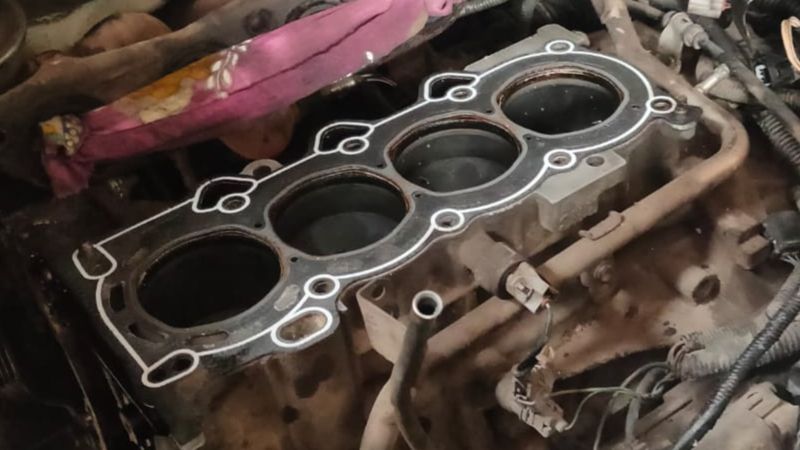Your classic muscle car is showing signs of trouble under the hood, and you suspect it could be an issue with the cylinder heads. As a gearhead, you know the cylinder heads are critical components in any engine that can make or break performance.
Before you start tearing into your engine to replace the heads, you’ll want to properly diagnose the problem. The first step is checking the cylinder head pressure to determine if it’s operating within the normal range.
If the pressure is off, it’s a clue that you likely have failing or faulty heads. Here, we’ll share some of the common problems of ported 862 heads with their solutions as well.
We’ll also share how to check cylinder head pressure. So, don’t wait anymore. Let’s dig into this article.

Problems and Solutions of Ported 862 Heads
While porting these heads can lead to significant performance gains, it’s essential to understand the potential problems. So, keep reading and know its common problems with their solutions.
Overheating
If your 862 heads are overheating, you should fix it as soon as possible. There are various reasons for it. Just check them:
Faulty Thermostat: The thermostat controls engine temperature. If it’s stuck open, it can’t regulate temperature properly. Replace it and you should be good to go.
Coolant Leak: Low coolant means less ability to absorb and remove heat. Check hoses, radiator, water pump, and cylinder heads for leaks. Seal or replace as needed.
Broken water Pump: The water pump circulates coolant to keep the engine from overheating. If it’s broken, coolant can’t flow, and heat builds up. Replace the water pump.
Clogged Radiator: A clogged radiator prevents maximum coolant flow, leading to overheating. Have the radiator been flushed or replaced?
Blown Head Gasket: If the head gasket is blown between cylinders, it allows coolant and exhaust to mix, reducing cooling ability. This requires cylinder head removal and gasket replacement. Overheating issues need to be addressed quickly to avoid costly damage.
By taking care of these issues you can solve ported head problems.
Oil Leaks
Oil leaks are one of the most common problems with ported 862 heads. If you notice oil spots in your driveway or garage, it’s time to check where it’s coming from.
The most common reasons for this issue are the valve cover gaskets, intake manifold gasket, or rear main seal.
To check the valve cover gaskets, start the engine and look for oil seeping around the edges of the valve covers. If there are leaks, the gaskets will need to be replaced. While you’re in there, inspect the valve train for any other issues.
Other areas to check include the timing cover seal, oil pan gasket, and front crankshaft seal. Any of these seals or gaskets deteriorate over time and with heat cycles.
Replacement of leaking seals and gaskets is critical to avoid losing expensive engine oil, prevent engine overheating or sludge build-up, and keep your engine running at peak performance.
With some time and patience, you can tackle these oil leaks yourself. Be sure to get the necessary replacement seals, gaskets, and fluids to finish the job.
Drop in Coolant Level
If you notice your coolant level dropping in your vehicle with ported 862 heads, it usually indicates there’s a leak somewhere in the cooling system. The most common causes for coolant loss in engines with these aluminum heads are:
Faulty Head Gasket
The head gasket seals the cylinder heads to the engine block. If it fails, it can allow coolant to seep into the combustion chambers or drip externally.
You may notice white smoke coming from the tailpipe, oil that looks like chocolate milk, or coolant puddling under the vehicle.
Replacing the head gasket usually requires removing the heads. If you need to do this, then call a mechanic to avoid potential engine damage.
Cracked Cylinder Head
Overheating an engine with ported 862 heads can potentially cause the aluminum cylinder heads to crack. When the heads crack, coolant escapes, and the engine overheats.
Cracked heads must be replaced. To avoid overheating and cracked heads, make sure your cooling system components like the water pump, thermostat, radiator, and hoses are all in working order.
Loose or Faulty Hose Clamp
A loose or faulty hose clamp on one of the coolant hoses can allow coolant to drip from the hose-to-component connection. Tighten or replace the hose clamp to fix the leak. Be sure to also inspect the hose for any cracks or damage and replace it if necessary.
To check for any of these potential issues and determine the cause of your coolant loss, you’ll want to do a cylinder leakage test and pressure test of the cooling system.
These tests, along with a physical inspection of the engine and components, should reveal where your coolant is escaping.
It will help you to have the necessary repairs done and get your engine temperature back to normal. With some TLC, your ported 862 heads can give you many more miles of driving enjoyment.
Smoke From Exhaust
If you notice smoke coming from your exhaust with ported 862 heads, it’s a sign there could be an issue that needs addressing.
Smoke is never a good sign, as it indicates inefficiency or damage. The color of the smoke can help determine the potential problem.
Blue Smoke
Seeing blue smoke usually means oil is burning in the combustion chamber. This could indicate worn valve seals, piston rings, or valve guides that are allowing oil to seep into the cylinder.
Have the cylinder head pressure tested to check for any air leaks. You may need to rebuild or replace worn components.
Black Smoke
Black smoke is a sign of a rich fuel mixture with too much fuel and not enough air. This could be caused by a faulty sensor, vacuum leak, or clogged air filter.
Check your air filter and replace it if needed. Also, check the engine sensors and vacuum lines for any issues. An engine tune-up may help optimize the air/fuel mixture.
White Smoke
White smoke usually means coolant is burning in the cylinders, indicating a possible cracked cylinder head or head gasket failure. Check the cylinder leakage for any cracks. You may need to replace the cylinder head gasket, or in severe cases possibly replace the cylinder head.
By systematically checking the cylinder head pressure and analyzing any smoke from the exhaust, you can better determine if your ported 862 heads need servicing or repair to get your engine running smoothly again.
How to Check Cylinder Head Pressure
To check your cylinder head pressure, you’ll need to perform a few diagnostic tests. The good news is, that these are very simple steps you can do yourself to determine if your heads need servicing or replacement.
Gather your Tools
You’ll need a compression tester, a socket set, and a torque wrench. A compression tester measures the pressure built up in the cylinders.
The socket set will allow you to remove the spark plugs so you can access the cylinders. The torque wrench ensures the spark plugs are tightened properly when reinstalled.
Remove the Spark Plugs
First, remove the spark plugs from your engine according to the spark plug replacement procedure in your vehicle’s service manual. This will allow the compression tester to get readings directly from the cylinders.
Attach the Compression Tester
Screw the compression tester into the spark plug hole of one cylinder at a time. Make sure it’s threaded in tightly for an accurate reading.
Crank the Engine
Have an assistant crank the engine for a few revolutions to build up pressure. For the most accurate reading, disable the fuel pump or ignition system to prevent the engine from starting. The compression gauge will display the highest reading achieved.
Check the Readings
A healthy, well-sealing cylinder head will show compression readings within 10 to 15 percent of the recommended pressure in your vehicle’s service manual.
Lower readings can indicate leaky or burnt valves, worn or damaged piston rings, or even a crack in the cylinder head or block. Significant differences between cylinders also point to trouble.
Reinstall the Spark Plugs
Remove the compression tester and reinstall the spark plugs, tightening them to the recommended torque in your manual. This completes the cylinder head pressure check.
Low or uneven readings mean it’s a good idea to have the cylinder heads inspected and tested further by a certified mechanic.
High-performance heads like the 862 or 706 heads may require porting and valve jobs to reach their full potential, so a compression test is always a good first diagnostic step.
Are 862 or 706 Heads Better?
When it comes to head comparison 706 vs. 862, we must say both of them are excellent cycling heads. But which design is better for your needs? It depends on what you’re looking for in performance and compatibility.
The 862 heads were introduced in the late ‘80s and early ‘90s. They feature a 170cc intake port that provides good low-end torque and throttle response.
The small port size means these heads work well for daily driving and stock rebuilds. However, the limited airflow can restrict high-RPM power. The 862s are also compatible with older small blocks from ‘55 to ‘85.
On the other hand, the 706 heads have a 210cc intake port, so they can handle more air and fuel for higher horsepower. They were designed for high-performance 350 blocks made after ‘87.
While the larger ports sacrifice some low-end power, the 706s allow for higher RPM operation and maximum top-end speed. These heads are ideal for hot rods, race cars, and other high-performance builds.
So, you need to evaluate how you plan to use your engine. If you want an easy retrofit for an older stock block and reliability for daily driving, the 862 heads are a great choice.
But for a high-performance build where maximum power is the goal, the 706 heads will give you the airflow and RPM range you need.
Either of these cylinder head models can work well, but they suit different needs. Think about your priorities and how you’ll use your Chevy small block to determine which option is better for your build.
Frequently Asked Questions
Q. Are 862 heads good for power?
The effectiveness of 862 heads for power largely depends on the specific engine and intended use. These heads are commonly associated with GM engines and can provide improved performance when properly matched with the right components and tuning.
Q. How much HP do ported heads add?
Ported heads can potentially add around 10 to over 50bhp to an engine’s output. However, the exact gain varies based on factors like engine type, quality of porting, and supporting modifications.
Q. What is the benefit of porting heads?
Porting heads involve reshaping and smoothing the intake and exhaust ports in an engine cylinder head. This process enhances airflow and improves combustion efficiency with power output.
Q. What Cam Works Best for 5.3L Engines With 862 Heads?
There is no definitive answer to which is the best cam for 5.3 with 862 heads. Different cams may suit different performance goals and preferences. Some of the popular choices are Texas Speed & Performance Magic Stick; Lunati Voodoo; Comp Cams Xtreme Energy etc.
Final Thought
Your cylinder heads are the key to your engine running well and lasting a long time. By keeping an eye on the problems of ported 862 heads, you can take action quickly.
Hopefully, this article is helpful enough for all of you to know the problems of these cycling heads with their solutions.
If you have anything to ask regarding it, just feel free to comment on us. We’ll surely try to answer you. Thank you all.
Read Also: How to Check Your Car Cooling System?


